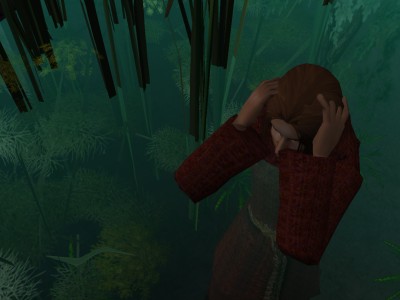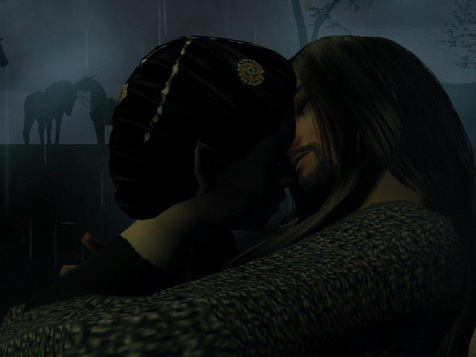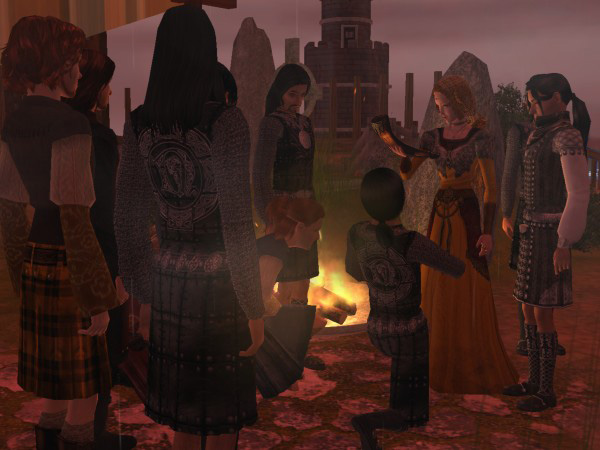
Loading...
The Kingdom of Lothere is an ongoing historical fantasy story set in the north of England in the decades following the Norman Conquest. The story is illustrated with screenshots from The Sims 2, and published chapter-by-chapter on the Web.
In 1066, William, Duke of Normandy, crossed the English Channel and defeated King Harold II of England at the Battle of Hastings. The Anglo-Saxon nobility all but vanished, either into exile in foreign countries, or into poverty or prison, or death.
Sigefrith Hwala and his friends, the “founding families” of this story, are members of that nobility. The story begins about six months after the battle.
The Kingdom of Lothere is less a novel than a chronicle of a place and time. Many stories are woven inseparably together.
It is also an alternative history of sorts, premised on the ripple effects of the survival of a single man. He was supposed to have died at Hastings, but he was saved by the interference of a very unusual raven.
The meddling of supernatural beings in the mundane world provides a subtle backdrop of fantasy, as does the existence of two dying races of elves who have little in common with Tolkien’s. The story’s real magic, however, is in its cast of unforgettable characters.
The Kingdom of Lothere is an enormous work, twice the size of the Bible or several times War and Peace. However, dozens of people have read it from start to the ever-advancing finish, some more than once. If you want to begin at the beginning, start here:
If you only want to taste a sample, start in the Storylines Section. There, I have pulled together chapters from some of the individual storylines that run through the larger work.
Each storyline is self-contained and can be read without any prior background. Brief notes summarize important information about events happening elsewhere.
Here are a few recommended storylines, but there are many more.
 “Red Boots” Quick, romantic, and fun, with a tragic twist and a happy ending.
“Red Boots” Quick, romantic, and fun, with a tragic twist and a happy ending.  “A Love Story” Lots of romance, lots of drama. (Ongoing.)
“A Love Story” Lots of romance, lots of drama. (Ongoing.)  “Storm on the Irish Sea” Politics, treachery, piracy, and war in the Celtic world surrounding Lothere. (Ongoing.)
“Storm on the Irish Sea” Politics, treachery, piracy, and war in the Celtic world surrounding Lothere. (Ongoing.)  “A Tangled Braid” Novel-length in itself, one of the premiere long-running storylines of Lothere. The story’s thorniest human/elf/elf love triangle. (Ongoing.)
“A Tangled Braid” Novel-length in itself, one of the premiere long-running storylines of Lothere. The story’s thorniest human/elf/elf love triangle. (Ongoing.) The Historical Context
If you are interested in the historical context of the story, you can begin by reading “The History of the Hwalas”, which summarizes the previous seventy years’ history of England as well as some background on the Anglo-Saxon noble families involved in the story. It is not required reading, however.
Latest Comments
- All
- Story
- Page
- Blog
-
- 62 weeks ago
- Aw, Devin! Not surprised you’re back for the...
- “Egelric's night is not wasted”
-
- 107 weeks ago
- Well hello everybody! I’ve been thinking of Lothere...
- “Egelric's night is not wasted”
-
- 158 weeks ago
- Just commenting to say how much I love the name...
- “Genetic inheritance in The Sims”
-
- 172 weeks ago
- You’re the best, Jenny <3
- “New Reader View for mobile phones and older eyes”
-
- 174 weeks ago
- Yay! It’s so nice to see lots of people are reading...
- “Lasrua says the wrong thing”
-
- 174 weeks ago
- Hi Jenny!! Just stopping by to say what joy...
- “Lasrua says the wrong thing”
-
- 174 weeks ago
- I definitely still lurk here allllll the time...
- “Lasrua says the wrong thing”
-
- 175 weeks ago
- Thank you, Lothere!
- “New Reader View for mobile phones and older eyes”
-
- 179 weeks ago
- Pen! Adie! (I know I’ve got you on Facebook, ...
- “Lasrua says the wrong thing”
-
- 179 weeks ago
- Adie!!! *waves*
- “Lasrua says the wrong thing”
-
- 62 weeks ago
- Aw, Devin! Not surprised you’re back for the...
- “Egelric's night is not wasted”
-
- 107 weeks ago
- Well hello everybody! I’ve been thinking of Lothere...
- “Egelric's night is not wasted”
-
- 174 weeks ago
- Yay! It’s so nice to see lots of people are reading...
- “Lasrua says the wrong thing”
-
- 174 weeks ago
- Hi Jenny!! Just stopping by to say what joy...
- “Lasrua says the wrong thing”
-
- 174 weeks ago
- I definitely still lurk here allllll the time...
- “Lasrua says the wrong thing”
-
- 179 weeks ago
- Pen! Adie! (I know I’ve got you on Facebook, ...
- “Lasrua says the wrong thing”
-
- 179 weeks ago
- Adie!!! *waves*
- “Lasrua says the wrong thing”
-
- 179 weeks ago
- I am actually in the middle of a reread. Am on...
- “Lasrua says the wrong thing”
-
- 179 weeks ago
- Who’s here in 2022? I’m only 13, and I love...
- “Lasrua says the wrong thing”
-
- 188 weeks ago
- Aw, Verity! Missed you. This is truly one of...
- “Lasrua says the wrong thing”
-
- More comments...
-
- 462 weeks ago
- Hey Jenny! I couldn’t find an email to contact...
- “About the author”
-
- 645 weeks ago
- Belated Happy Canada Day .… and Happy 4th of ...
- “About the author”
-
- 656 weeks ago
- Playable harps!!! Maybe Jehanne will learn to...
- “Where can I get...?”
-
- 660 weeks ago
- Hi Jenny, greetings from Germany! Like Tiffany...
- “About the author”
-
- 660 weeks ago
- Just thinking of you, Jenny! I hope you are doing...
- “About the author”
-
- 665 weeks ago
- Plus sized gowns!
- “Where can I get...?”
-
- 668 weeks ago
- Bunnies are always a good way to get attention...
- “About the author”
-
- 668 weeks ago
- And a quick “Howdy” Just because ...
- “About the author”
-
- 680 weeks ago
- I didn’t see the message, but I too am glad you...
- “About the author”
-
- 680 weeks ago
- phewwww! *wipes the worry-lines from forehead...
- “About the author”
-
- 158 weeks ago
- Just commenting to say how much I love the name...
- “Genetic inheritance in The Sims”
-
- 172 weeks ago
- You’re the best, Jenny <3
- “New Reader View for mobile phones and older eyes”
-
- 175 weeks ago
- Thank you, Lothere!
- “New Reader View for mobile phones and older eyes”
-
- 191 weeks ago
- I’m sorry, it looks like I just linked to oph3lia...
- “Robin Hood recolors”
-
- 191 weeks ago
- The mesh download is not working. I made an account...
- “Robin Hood recolors”
-
- 191 weeks ago
- This does not show the sims that I have made ...
- “Change skin or eyes in SimPE”
-
- 348 weeks ago
- helpful: 2d6839c5-0b7c-48a1-9c55-4bd9cc873b0f...
- “Change skin or eyes in SimPE”
-
- 369 weeks ago
- I’m so touched! I like to come back now and again...
- “All The Spoilers: Happily Ever After”
-
- 369 weeks ago
- I started reading this when I was a sophomore...
- “All The Spoilers: Happily Ever After”
-
- 404 weeks ago
- It still blows my mind that all of this was going...
- “All The Spoilers: Nine Sisters and the Apocalypse”
-
- More comments...
Latest Extras
-
- Blog post
- 624 weeks ago
- “But Also the End”
-
- Blog post
- 676 weeks ago
- “Thank you, and more”
-
- Blog post
- 676 weeks ago
- “Seven Year Itch”
-
- Blog post
- 624 weeks ago
- “But Also the End”
-
- Blog post
- 676 weeks ago
- “Thank you, and more”
-
- Blog post
- 676 weeks ago
- “Seven Year Itch”
New in the Forum
-
- 239 weeks ago
- I love that you're out there...
- “Works similar to Lothere?”



























